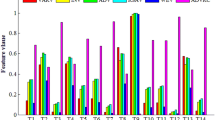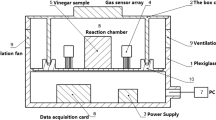Abstract
Fisher discriminant analysis (FDA) is a very useful pattern recognition technique widely used in electronic nose system (e-nose). However, due to its linear characteristic, the classification problems of multi-class and high-dimensional e-nose data cannot be handled effectively. Therefore, a Gaussian-based kernel FDA (KFDA) method is proposed to solve multi-class and high-dimensional classification problems of complex samples such as food classification using e-nose. The key point of the method is how to determine the Gaussian kernel parameter. Firstly, according to distance discriminant analysis viewpoint, a desired kernel matrix adapted to Gaussian kernel function can be given successfully. Secondly, an evaluation function based on Euclidean distance is established for measuring the degree of approximation between actual kernel matrix containing an unknown Gaussian kernel parameter and the desired kernel matrix so as to get an optimal solution of the parameter, and then the actual kernel matrix can be definitely determined. Finally, the principal component analysis (PCA) for the actual kernel matrix is carried out. Meanwhile, FDA for the principal component matrix generated by PCA is also implemented in succession, and the KFDA is completed. Six kinds of Chinese spirit and six kinds of Chinese vinegar samples as two classification applications were respectively carried out accurately with the KFDA method; and the KFDA method is tested to be very simple and effective. The KFDA method may be promising for complex samples classification dataset of e-nose.





Similar content being viewed by others
References
M. Padilla, A. Perera, I. Montoliu, A. Chaudry, K. Persaud, S. Marco, Drift compensation of gas sensor array data by Orthogonal Signal Correction. Chemom. Intell. Lab. 100, 28–35 (2010)
A.C. Romain, J. Nicolas, Long term stability of metal oxide-based gas sensors for e-nose environmental applications: an overview. Sens. Actuators B Chem. 146, 502–506 (2010)
A. Loutfi, S. Coradeschi, G.K. Mani, P. Shankar, J.B.B. Rayappan, Electronic noses for food quality: a review. J. Food Eng. 144, 103–111 (2015)
X. Hong, J. Wang, G. Qi, Comparison of spectral clustering, K-clustering and hierarchical clustering on e-nose datasets: application to the recognition of material freshness, adulteration levels and pretreatment approaches for tomato juices. Chemom. Intell. Lab. 133, 17–24 (2014)
Z. Xu, X. Shi, S. Lu, Integrated sensor array optimization with statistical evaluation. Sens. Actuators B Chem. 149, 239–244 (2010)
L. Zhang, F. Tian, G. Pei, A novel sensor selection using pattern recognition in electronic nose. Measurement 54, 31–39 (2014)
M. Zuppa, C. Distante, P. Siciliano, K.C. Persaud, Drift counteraction with multiple self-organising maps for an electronic nose. Sens. Actuators B Chem. 98, 305–317 (2004)
D. Cao, Y. Liang, Q. Xu, Q. Hu, L. Zhang, G. Fu, Exploring nonlinear relationships in chemical data using kernel-based methods. Chemom. Intell. Lab. 107, 106–115 (2011)
H. Peng, B. Li, X. Luo, J. Wang, Z. Zhang, A learning-based audio watermarking scheme using kernel Fisher discriminant analysis. Digit Signal Process 23, 382–389 (2013)
R. Khemchandani, Jayadeva, S. Chandra, Learning the optimal kernel for Fisher discriminant analysis via second order cone programming. Eur. J. Oper. Res. 203, 692–697 (2010)
S. He, P. Pan, L. Dai, H. Wang, J. Liu, Application of kernel-based Fisher discriminant analysis to map landslide susceptibility in the Qinggan River delta, Three Gorges, China. Geomorphology 171–172, 30–41 (2012)
L. Zhang, F.-C. Tian, A new kernel discriminant analysis framework for e-nose recognition. Anal. Chim. Acta 816, 8–17 (2014)
J. Liu, F. Zhao, Y. Liu, Learning kernel parameters for kernel Fisher discriminant analysis. Pattern Recogn. Lett. 34, 1026–1031 (2013)
K. Müller, S. Mika, G. Rätsch, K. Tsuda, B. Schölkopf, An introduction to kernel-based learning algorithms. IEEE T. Neural Netw. 12, 181–201 (2001)
I. Rodriguez-Lujan, C. Santa Cruz, R. Huerta, On the equivalence of kernel Fisher discriminant analysis and kernel quadratic programming feature selection. Pattern Recogn. Lett. 32, 1567–1571 (2011)
A. Diaf, B. Boufama, R. Benlamri, Non-parametric Fisher’s discriminant analysis with kernels for data classification. Pattern Recogn. Lett. 34, 552–558 (2013)
A.R. Teixeira, A.M. Tome, K. Stadlthanner, E.W. Lang, KPCA denoising and the pre-image problem revisited. Digit Signal Process 18, 568–580 (2008)
J. Yang, Z. Jin, J.Y. Yang, D. Zhang, A.F. Frangi, Essence of kernel Fisher discriminant: KPCA plus LDA. Pattern Recogn. 37, 2097–2100 (2004)
Y. Xiao, H. Wang, L. Zhang, W. Xu, Two methods of selecting Gaussian kernel parameters for one-class SVM and their application to fault detection. Knowl.-Based Syst. 59, 75–84 (2014)
Z. Zhu, Z. Song, Fault diagnosis based on imbalance modified kernel Fisher discriminant analysis. Chem. Eng. Res. Des. 88, 936–951 (2010)
D. You, O.C. Hamsici, A.M. Martinez, Kernel optimization in discriminant analysis. IEEE T. Pattern Anal. 33, 631–638 (2011)
T.P. Centeno, N.D. Lawrence, Optimising kernel parameters and regularization coefficients for non-linear discriminant analysis. J. Mach. Learn. Res. 7, 455–491 (2006)
P. Chudzian, Evaluation measures for kernel optimization. Pattern Recogn. Lett. 33, 1108–1116 (2012)
K. Wu, S. Wang, Choosing the kernel parameters for support vector machines by the inter-cluster distance in the feature space. Pattern Recogn. 42, 710–717 (2009)
C.H. Wu, G.H. Tzeng, R.H. Lin, A Novel hybrid genetic algorithm for kernel function and parameter optimization in support vector regression. Expert Syst. Appl. 36, 4725–4735 (2009)
Y. Yin, X. Tian, Classification of Chinese drinks by a gas sensors array and combination of the PCA with Wilks distribution. Sens. Actuators B Chem. 124, 393–397 (2007)
Y. Yin, H. Yu, B. Chu, Y. Xiao, A sensor array optimization method of electronic nose based on elimination transform of Wilks statistic for discrimination of three kinds of vinegars. J. Food Eng. 127, 43–48 (2014)
Y. Yin, B. Chu, H. Yu, Y. Xiao, A selection method for feature vectors of electronic nose signal based on wilks Λ–statistic. J. Food Meas. Charact. 8, 29–35 (2014)
Acknowledgments
This work is supported by the National Natural Science Foundation of China (NSFC) under Grant No. 31571923, the authors acknowledge the support.
Author information
Authors and Affiliations
Corresponding author
Rights and permissions
About this article
Cite this article
Yin, Y., Hao, Y., Bai, Y. et al. A Gaussian-based kernel Fisher discriminant analysis for electronic nose data and applications in spirit and vinegar classification. Food Measure 11, 24–32 (2017). https://doi.org/10.1007/s11694-016-9367-3
Received:
Accepted:
Published:
Issue Date:
DOI: https://doi.org/10.1007/s11694-016-9367-3




